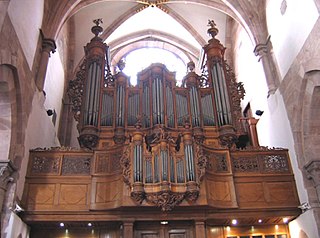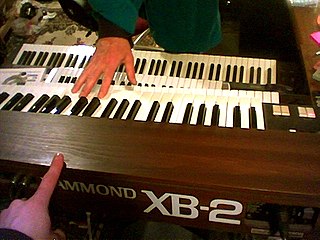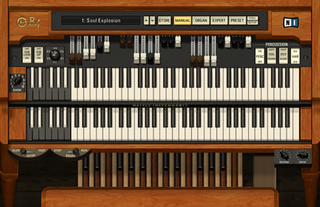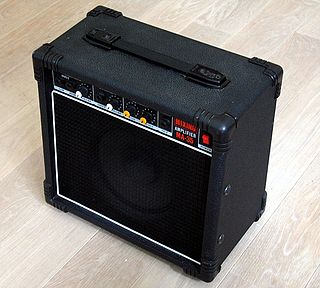
The Hammond organ is an electric organ invented by Laurens Hammond and John M. Hanert and first manufactured in 1935. Multiple models have been produced, most of which use sliding drawbars to vary sounds. Until 1975, Hammond organs generated sound by creating an electric current from rotating a metal tonewheel near an electromagnetic pickup, and then strengthening the signal with an amplifier to drive a speaker cabinet. The organ is commonly used with the Leslie speaker.

In music, the organ is a keyboard instrument of one or more pipe divisions or other means for producing tones, each played from its own manual, with the hands, or pedalboard, with the feet.

The Leslie speaker is a combined amplifier and loudspeaker that projects the signal from an electric or electronic instrument and modifies the sound by rotating a baffle chamber ("drum") in front of the loudspeakers. A similar effect is provided by a rotating system of horns in front of the treble driver. It is most commonly associated with the Hammond organ, though it was later used for the electric guitar and other instruments. A typical Leslie speaker contains an amplifier, a treble horn and a bass speaker—though specific components depend upon the model. A musician controls the Leslie speaker by either an external switch or pedal that alternates between a slow and fast speed setting, known as "chorale" and "tremolo".

An electronic keyboard, portable keyboard, or digital keyboard is an electronic musical instrument, an electronic derivative of keyboard instruments. Electronic keyboards include synthesizers, digital pianos, stage pianos, electronic organs and digital audio workstations. In technical terms, an electronic keyboard is a synthesizer with a low-wattage power amplifier and small loudspeakers.

An electric organ, also known as electronic organ, is an electronic keyboard instrument which was derived from the harmonium, pipe organ and theatre organ. Originally designed to imitate their sound, or orchestral sounds, it has since developed into several types of instruments:

A pedalboard is a keyboard played with the feet that is usually used to produce the low-pitched bass line of a piece of music. A pedalboard has long, narrow lever-style keys laid out in the same semitone scalar pattern as a manual keyboard, with longer keys for C, D, E, F, G, A and B, and shorter, raised keys for C♯, D♯, F♯, G♯ and A♯. Training in pedal technique is part of standard organ pedagogy in church music and art music.

A MIDI controller is any hardware or software that generates and transmits Musical Instrument Digital Interface (MIDI) data to MIDI-enabled devices, typically to trigger sounds and control parameters of an electronic music performance. They most often use a musical keyboard to send data about the pitch of notes to play, although a MIDI controller may trigger lighting and other effects. A wind controller has a sensor that converts breath pressure to volume information and lip pressure to control pitch. Controllers for percussion and stringed instruments exist, as well as specialized and experimental devices. Some MIDI controllers are used in association with specific digital audio workstation software. The original MIDI specification has been extended to include a greater range of control features.

A sound module is an electronic musical instrument without a human-playable interface such as a piano-style musical keyboard. Sound modules have to be operated using an externally connected device, which is often a MIDI controller, of which the most common type is the musical keyboard. Another common way of controlling a sound module is through a sequencer, which is computer hardware or software designed to record and playback control information for sound-generating hardware. Connections between sound modules, controllers, and sequencers are generally made with MIDI, which is a standardized interface designed for this purpose.

A manual is a musical keyboard designed to be played with the hands, on an instrument such as a pipe organ, harpsichord, clavichord, electronic organ, melodica, or synthesizer. The term "manual" is used with regard to any hand keyboard on these instruments to distinguish it from the pedalboard, which is a keyboard that the organist plays with their feet. It is proper to use "manual" rather than "keyboard", then, when referring to the hand keyboards on any instrument that has a pedalboard.

Bass pedals are an electronic musical instrument with a foot-operated pedal keyboard with a range of one or more octaves. The earliest bass pedals from the 1970s consisted of a pedalboard and analog synthesizer tone generation circuitry packaged together as a unit. The bass pedals are plugged into a bass amplifier or PA system so that their sound can be heard. Since the 1990s, bass pedals are usually MIDI controllers, which have to be connected to a MIDI-compatible computer, electronic synthesizer keyboard, or synth module to produce musical tones. Some 2010s-era bass pedals have both an onboard synth module and a MIDI output.

A clonewheel organ is an electronic musical instrument that emulates the sound of the electromechanical tonewheel-based organs formerly manufactured by Hammond from the 1930s to the 1970s. Clonewheel organs generate sounds using solid-state circuitry or computer chips, rather than with heavy mechanical tonewheels, making clonewheel organs much lighter-weight and smaller than vintage Hammonds, and easier to transport to live performances and recording sessions.

The Nord Electro is a series of electronic keyboards, developed in Sweden by Clavia, that digitally emulate electro-mechanical keyboards, such as electric pianos and electronic organs, while designed to be highly portable.
The Nord Stage is a digital keyboard or stage piano, manufactured by Clavia Digital Music Instruments of Stockholm, Sweden. There have been five editions of the instrument: the original Nord Stage in 2005, the Nord Stage EX in 2008, the Nord Stage 2 in 2011, the Nord Stage 2 EX in 2015, and the Nord Stage 3 in 2017.

The Vox Continental is a transistorised combo organ that was manufactured between 1962 and 1971 by the British musical equipment manufacturer Vox. It was designed for touring musicians and as an alternative to the heavy Hammond organ. It supports drawbars in a similar manner to the Hammond, and has distinctive reverse-coloured keys. The sound is generated by a series of oscillators, using a frequency divider to span multiple octaves.

The B4 Organ II is a discontinued commercial, proprietary software synthesizer made by Native Instruments. The software runs as a stand-alone executable, or as a VST, DXi, or RTAS plugin in a Digital audio workstation. The software is an example of a "Clonewheel organ", an attempt at recreating the sound of a Hammond organ using software synthesis.

A keyboard amplifier is a powered electronic amplifier and loudspeaker in a wooden speaker cabinet used for amplification of electronic keyboard instruments. Keyboard amplifiers are distinct from other types of amplification systems such as guitar amplifiers due to the particular challenges associated with making keyboards sound louder on stage; namely, to provide solid low-frequency sound reproduction for the deep basslines which keyboards can play and crisp high-frequency sound for the high-register notes. Another difference between keyboard amplifiers and guitar/bass amplifiers is that keyboard amps are usually designed with a relatively flat frequency response and low distortion. In contrast, many guitar and bass amp designers purposely make their amplifiers modify the frequency response, typically to "roll off" very high frequencies, and most rock and blues guitar amps, and since the 1980s and 1990s, even many bass amps are designed to add distortion or overdrive to the instrument tone.
The Korg CX-3 is an electronic clonewheel organ with drawbars that simulates the sound of an electromechanical Hammond organ and the Leslie speaker, a rotating speaker effect unit. The CX-3 was first introduced in 1979.

Diversi Musical Products, Inc is a manufacturer of electric organs. It specializes in making clones of the Hammond organ and became popular when jazz organists "Papa" John and Joey DeFrancesco "defected" from Hammond to using their organs instead.
The VK-8 Combo Organ is a discontinued electronic keyboard introduced in 2002, which simulates the sound of an electromechanical tonewheel-based Hammond organ. The VK-8 is both an improvement and successor to both the VK-7 and VK-77. The VK-8 itself was succeeded by the VK-88.

A digital accordion is an electronic musical instrument that uses the control features of a traditional accordion to trigger a digital sound module that produces synthesized or digitally sampled accordion sounds or, in most instruments, a range of non-accordion sounds, such as orchestral instruments, pipe organ, piano, guitar, and so on. Digital accordions typically encode and transmit key presses and other input as Musical Instrument Digital Interface (MIDI) messages. Most digital accordions need to be plugged into a keyboard amplifier or PA system to hear their sounds.

















